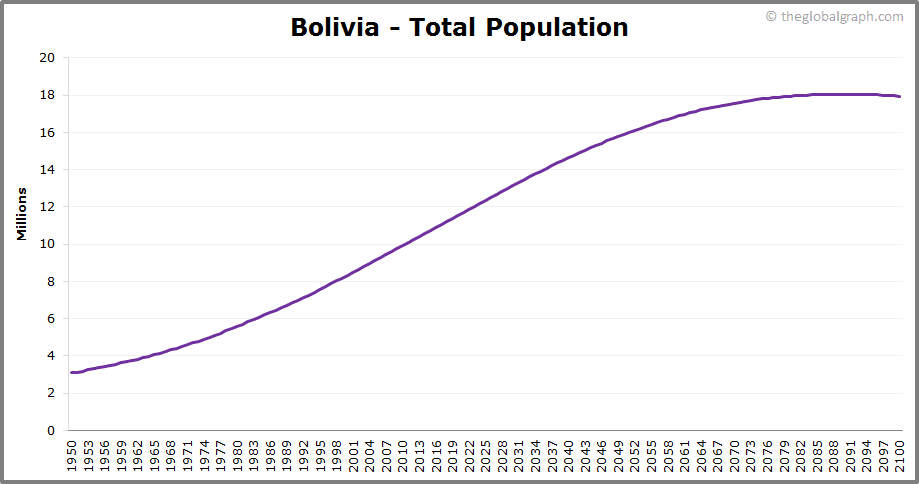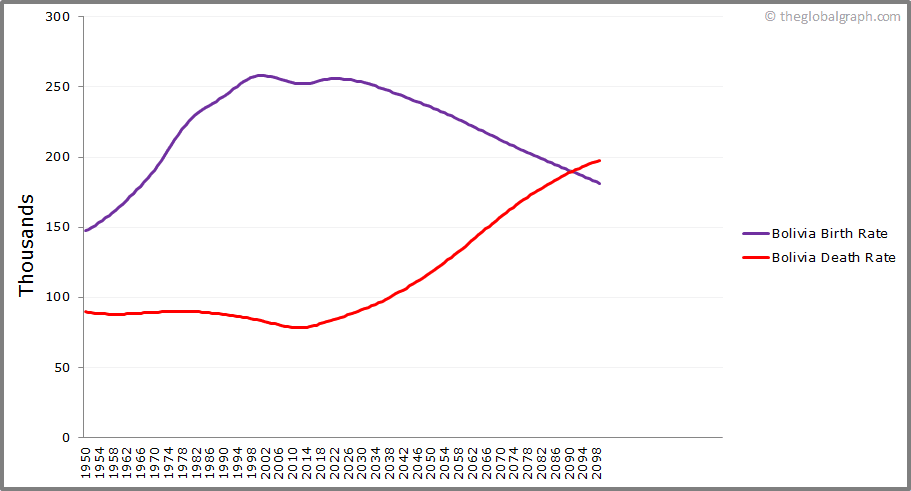Highlights of Analysis:
- Bolivia Population is increasing
- Bolivia Population Density is increasing
- Bolivia Life Expectancy is increasing
- Bolivia Fertility Rate is decreasing
Every year Bolivia population is expected to increase by 89200 people. Bolivia contributes 0.15% of world's total population. Average Life Expectancy in Bolivia is 70.449 and is expected to Increase in upcoming next 50 years.Life Expectancy is below average when compared to global average (Currently Hong Kong Ranks 1st for Life Expectancy of 85 years).
How the
world population is changing is of great importance for humanity’s impact on the Earth’s natural environment, but it also gives reasons to hope for a good future.
Bolivia owns 0.00727% of land i.e. 1083300 Sq Kms of land and Ranks 26
when compared to other
Global Countries Land area
Bolivia Population, Density, Fertility Rate and Life Expectancy Overview
| Bolivia Population Analysis |
Year 2010 |
Year 2020 |
Year 2030 |
| Bolivia Population (in million)
|
9.91 |
11.54 |
13.15 |
| Bolivia Global Rank
|
86th |
82nd |
80th |
| Bolivia Global Population Share
|
0.14% |
0.14% |
0.15% |
| Bolivia Global Population Density
|
9.27 |
10.75 |
12.04 |
| Bolivia Global Population Density Rank
|
136th |
138th |
140th |
| Bolivia Average Life Expectancy
|
66.4 |
70.44 |
73.18 |
| Bolivia Average Life Expectancy Global Rank
|
145th |
137th |
128th |
| Bolivia Fertility Rate
|
3.2 |
2.73 |
2.44 |
| Bolivia Fertility Rate Global Rank
|
66th |
68th |
67th |
Note : Population Density means number of people staying per kilometer and Fertility rate means number of kids born per women
What is the Population trend of
Bolivia
?
- Every year Bolivia population is expected to increase by 89200 people.
- Bolivia population overall trend is expected to be Decreasing for next 50 years and expected to be in Decreasing trend for next 100 years.
- As per trend analysis Bolivia will have more death than births from 2091 and this will impact population growth.
- Bolivia Global Population Rank for next 50 years is expected to be in Range of 82nd-81st.
What is the Population growth rate of
Bolivia
?
- Bolivia population average growth rate for next 50 years is increasing at Rate of 0.98%.
- Overall population growth rate of Bolivia is expected to be decreasing starting Year : 2089.
- Bolivia contributes 0.15% of world's total population.
Table : Past and Expected Future
Population & Global Rank
| Year |
Count(in Millions) |
Global Rank |
| 2010 |
9.91 Million |
86th |
| 2020 |
11.54 Million |
82nd |
| 2030 |
13.15 Million |
80th |
| 2040 |
14.64 Million |
81st |
| 2050 |
15.9 Million |
81st |
| 2060 |
16.89 Million |
81st |
| 2070 |
17.57 Million |
80th |
| 2080 |
17.94 Million |
80th |
| 2090 |
18.05 Million |
81st |
| 2100 |
17.94 Million |
81st |
Table : Past and Expected Future Population Growth Rate
| Year |
Count(in Millions) |
Growth Rate |
| 2010 |
9.91 Million |
1.63% |
| 2020 |
11.54 Million |
1.45% |
| 2030 |
13.15 Million |
1.22% |
| 2040 |
14.64 Million |
0.97% |
| 2050 |
15.9 Million |
0.73% |
| 2060 |
16.89 Million |
0.52% |
| 2070 |
17.57 Million |
0.31% |
| 2080 |
17.94 Million |
0.14% |
| 2090 |
18.05 Million |
0.01% |
| 2100 |
17.94 Million |
-0.08% |
Table : Past and Expected Future Population Share in world
| Year |
Count(in Millions) |
Share |
| 2010 |
9.91 Million |
0.14% |
| 2020 |
11.54 Million |
0.14% |
| 2030 |
13.15 Million |
0.15% |
| 2040 |
14.64 Million |
0.15% |
| 2050 |
15.9 Million |
0.16% |
| 2060 |
16.89 Million |
0.16% |
| 2070 |
17.57 Million |
0.16% |
| 2080 |
17.94 Million |
0.16% |
| 2090 |
18.05 Million |
0.16% |
| 2100 |
17.94 Million |
0.16% |
Bolivia
Population Density
- Bolivia population density is 12.76 per sq. km and is expected to be Decreasing for next 50 years.
- Bolivia Ranks in range of 138th-146th in term of population density around the world.
- As per trend, their will be decrease in population density of Bolivia.
Table : Past and Expected Future Population Density (people per sq. km.)
`
| Year |
Population Density |
Rank |
| 2010 |
9.27 |
136th |
| 2020 |
10.75 |
138th |
| 2030 |
12.04 |
140th |
| 2040 |
13.06 |
142nd |
| 2050 |
13.77 |
144th |
| 2060 |
14.16 |
146th |
| 2070 |
14.18 |
148th |
| 2080 |
13.84 |
150th |
| 2090 |
13.17 |
152nd |
| 2100 |
12.21 |
154th |
Bolivia
Average Life Expectancy
- Average Life Expectancy in Bolivia is 70.449 and is expected to Increase in upcoming next 50 years.
- Life Expectancy is below average when compared to global average (Currently Hong Kong Ranks 1st for Life Expectancy of 85 years).
- Bolivia ranks 137th in terms of average life expectancy around the world.
Table : Past and Expected Average Life Expectancy (Age) (Source)
| Year |
Average Life Expectancy |
Rank |
| 2010 |
66.4 |
145th |
| 2020 |
70.44 |
137th |
| 2030 |
73.18 |
128th |
| 2040 |
75.37 |
123rd |
| 2050 |
77.28 |
120th |
| 2060 |
79.03 |
119th |
| 2070 |
80.69 |
119th |
| 2080 |
82.26 |
117th |
| 2090 |
83.71 |
117th |
| 2100 |
0 |
|
Bolivia
Average Fertility Rate
- In Bolivia, Women gives birth to 2.73 (average) children every year and this fertility rate is expected to be in decreasing trend.
- Bolivia rank is in range of 68th-66th in term of average fertility rate around the world.
Table : Past and Expected Average Fertility Rate
| Year |
Average Fertility Rate |
Rank |
| 2010 |
3.2 |
66th |
| 2020 |
2.73 |
68th |
| 2030 |
2.44 |
67th |
| 2040 |
2.23 |
67th |
| 2050 |
2.07 |
67th |
| 2060 |
1.96 |
66th |
| 2070 |
1.88 |
72nd |
| 2080 |
1.84 |
81st |
| 2090 |
1.81 |
99th |
| 2100 |
1.8 |
112th |
Conclusion of Analysis :
In 1950, Bolivia population was 3089646 and this continuously increasing at growth rate of average 0.02%.Currently Bolivia population is around 9918242 and by year 2030 its expected to be 13158072 .Bolivia ranks 86th when compared to other countries population. Average Life Expectancy of Bolivia in 2010 was 66.408, in 2020 its 70.449 and by 2050 it will be 77.282.As mentioned in Highlight's Bolivia population is increasing, population density is increasing, average life expectancy is increasing and average fertility rate is decreasing.
Reference (Source) :
- https://population.un.org/wpp/
- https://population.un.org/wpp/DataSources/
- https://www.wikipedia.org/
Historical population data on a sub-national level – including their administrative divisions and principal towns – is collected by Jan Lahmeyer and published at his website
www.populstat.info.
The Minnesota Population Center publishes various high-quality datasets based on census data beginning in 1790. At the time of writing this source was online at
www.pop.umn.edu/index.php. It focuses on North America and Europe.
The Data & Information Services Center (DISC) Archive at University of Wisconsin-Madison provides access to census data and population datasets (mostly for the Americas). At the time of writing this source was online at
http://www.disc.wisc.edu.
The Atlas of the Biosphere publishes data on Population Density. At the time of writing this source was online at
www.sage.wisc.edu/atlas/maps.
This research was last modified on
.







